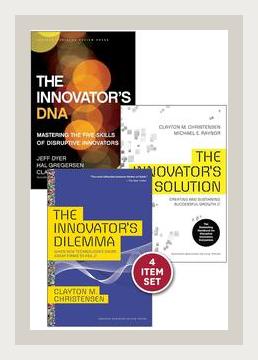Innovation and CreativityR&D Management
“Disruptive Innovation: The Christensen Collection” encapsulates three seminal works: “The Innovator’s Dilemma,” “The Innovator’s Solution,” and “The Innovator’s DNA,” which collectively provide a comprehensive guide to fostering innovation in the business landscape.
1. The Innovator’s Dilemma
Major Points:
– Disruptive vs. Sustaining Innovations: Disruptive innovations create new markets by offering simpler, more affordable products or services that initially appeal to new or less-demanding customers. Sustaining innovations improve existing products for existing markets.
– Example: The steel mini mills disrupted the traditional, integrated steel mills by initially producing low-quality steel at lower costs.
– Action: Identify areas within your industry where new, simpler, and more affordable products might appeal to a different customer segment.
- Why Great Companies Fail: Established firms focus on sustaining innovations because they cater to the higher-paying segments of the market, thereby neglecting lower-end or emerging segments where disruptors enter.
- Example: Digital photography initially offered lower quality compared to film; giants in photography like Kodak continued focusing on traditional film due to higher profit margins.
-
Action: Allocate resources towards exploring disruptive innovations, even if they currently have lower margins.
-
Resource Allocation Process: How a firm prioritizes where to invest resources can hinder embracing disruptive technology.
- Example: HP’s insistence on enhancing laser printers instead of exploring initially inferior inkjet technology allowed new players to capture a segment of the market.
- Action: Create separate teams with distinct criteria and budgets to pursue potentially disruptive technologies.
2. The Innovator’s Solution
Major Points:
– Creating New Markets: Rather than battling for dominance within existing markets, companies should look to create new markets or reshape existing ones.
– Example: Southwest Airlines redefined air travel by offering a no-frills, low-cost option targeting commuters who would otherwise travel by car or bus.
– Action: Conduct market research to identify unmet needs or customer pain points that can be addressed with a new market offering.
- Job-to-Be-Done Framework: Understand what jobs consumers are trying to do when they “hire” a product or service. This goes beyond superficial demographics to the core reasons for their purchase decision.
- Example: When people “hired” a milkshake, it turned out they wanted something to keep them occupied during a long commute, leading to product innovations.
-
Action: Engage in observational research and customer interviews to determine the jobs customers are hiring your product to do.
-
Modularity vs. Interdependence: Innovations may require interdependent architectures when performance is critical; modularity can be introduced as performance exceeds customer needs and competitive pressure builds.
- Example: Initially, the personal computer market was dominated by integrated products like Apple’s earliest models. Over time, modular PCs from companies like IBM and Dell expanded the market.
- Action: Assess the performance needs of your core products periodically and explore modular designs to reduce costs and encourage ecosystem growth.
3. The Innovator’s DNA
Major Points:
– Discovery Skills: Innovators possess five key skills: associating, questioning, observing, networking, and experimenting.
– Example: Jeff Bezos’s observation of the rapid growth of internet activity and his experimentation toward creating a seamless shopping experience drove the success of Amazon.
– Action: Develop a routine to practice these discovery skills. For instance, spend time networking with diverse individuals outside your industry to gain novel insights.
- Innovative Culture: Creating a culture that encourages innovation requires setting the right processes and providing incentives aligned with innovative outcomes.
- Example: Google’s ‘20% time’ policy allows employees to work on projects outside their primary responsibilities, fostering a plethora of innovations like Gmail.
-
Action: Implement policies and practices that provide employees with time and resources to explore new ideas without the immediate pressures of their regular responsibilities.
-
Systematic Innovation Process: Innovation can be systematically generated with the right methodologies in place, including experimentation and iterative feedback loops.
- Example: Intuit uses rapid experimentation cycles in the development of its financial planning software, continually refining products based on user feedback.
- Action: Adopt a Lean Startup methodology, incorporating MVPs (Minimum Viable Products) and iterative development to quickly test assumptions and refine innovations.
Conclusion
“Disruptive Innovation: The Christensen Collection” empowers businesses and individuals with a structured approach to foster and manage innovation. To effectively leverage the insights from these books:
Key Actions:
1. Identify Potential Disruptive Innovations: Constantly scout for simpler, more affordable technologies or products that could tap into new markets.
2. Allocate Experimental Resources: Create separate units with distinct leadership and funding to explore disruptive technologies without the constraints of supporting core operations.
3. Understand Customer Jobs: Use the job-to-be-done framework to gain deeper insights into why customers use your products or services and innovate around these needs.
4. Foster an Innovative Culture: Encourage discovery skills among your team and provide the necessary freedom and resources for experimentation.
5. Implement Systematic Processes: Establish methodological processes for innovation, focusing on rapid experimentation, feedback loops, and iterative improvements.
By following these guidelines, organizations can better navigate the complexities of innovation, ensuring they remain competitive in a rapidly evolving business environment.
